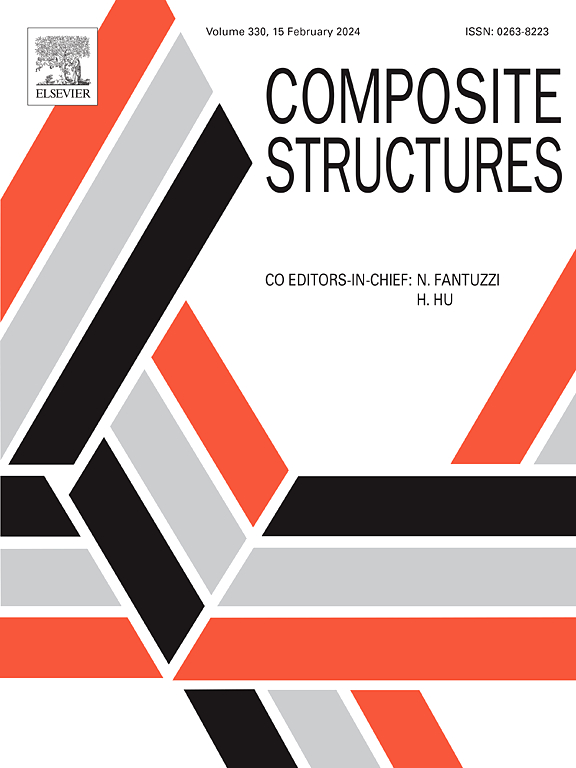薄壁复合材料圆柱体模态、静态和屈曲行为的对比分析:详细研究
IF 6.3
2区 材料科学
Q1 MATERIALS SCIENCE, COMPOSITES
引用次数: 0
摘要
本研究深入探讨了航空航天、汽车、舰船和土木工程等领域不可或缺的分层复合材料圆柱体的屈曲动力学、模态和静态分析。复合材料具有优异的强度重量比和设计适应性,因此对复合材料的依赖性不断增加,这就需要深入研究复合材料的失效模式,重点是分层。本研究采用系统分析框架,描述了分层对复合材料圆柱体结构完整性的复杂影响,强调了屈曲行为、模态特征和静态性能之间的协同作用。该方法包括模拟一系列相同的筒体,每个筒体都有不同程度的分层,在三个不同的测试中进行比较分析。程序阶段包括指定筒体结构和分层参数,应用数值建模技术进行静态、模态和屈曲分析,以及对结果进行全面的相关性分析。结果表明,虽然纤维角度对模态和屈曲结果的影响可以忽略不计,但在静态分析中,0°取向会显著增加结构坍塌的可能性。此外,分析结果之间的相关性研究强调了结果的独立性,因此有必要在圆柱形结构开发或维护验证中进行彻底验证。值得注意的是,分层沿轴线的位置、角度和纵横比是影响静态结果的关键参数。这项研究不仅拓宽了我们对复合材料行为的理解,还强调了对先进分析模型的需求,以预测和缓解故障,从而提高材料设计和工程系统的可靠性。本文章由计算机程序翻译,如有差异,请以英文原文为准。
Comparative analysis of modal, static, and buckling behaviors in thin-walled composite cylinders: A detailed study
This investigation delves into the dynamics of buckling, modal, and static analyses within delaminated composite cylinders, integral to sectors such as aerospace, automotive, naval, and civil engineering. The escalating dependence on composite materials, attributed to their exceptional strength-to-weight ratio and adaptability in design, necessitates a deep dive into their failure modes, with a focus on delamination. Employing a systematic analytical framework, this study delineates the intricate impact of delamination on the structural integrity of composite cylinders, underscoring the synergy between buckling behavior, modal characteristics, and static performance. The methodology includes simulating a series of identical tubes, each with varying degrees of delamination, to perform a comparative analysis across three distinct tests. The procedural stages include specifying the parameters for cylinder construction and delamination, applying numerical modeling techniques for static, modal, and buckling analyses, and conducting a comprehensive correlation analysis of the outcomes. The results indicate that while fiber angles have a negligible impact on modal and buckling results, a 0°orientation significantly increases the likelihood of structural collapse in static analysis. Additionally, the correlation study among the analyses underscores the independence of results, necessitating thorough verifications in cylindrical structure development or maintenance validations. Notably, the position along the axis, the angle, and the aspect ratio of delamination are critical parameters influencing static outcomes. This research not only broadens our understanding of composite material behavior but also emphasizes the need for advanced analytical models to predict and mitigate failures, thus enhancing material design and the reliability of engineering systems.
求助全文
通过发布文献求助,成功后即可免费获取论文全文。
去求助
来源期刊

Composite Structures
工程技术-材料科学:复合
CiteScore
12.00
自引率
12.70%
发文量
1246
审稿时长
78 days
期刊介绍:
The past few decades have seen outstanding advances in the use of composite materials in structural applications. There can be little doubt that, within engineering circles, composites have revolutionised traditional design concepts and made possible an unparalleled range of new and exciting possibilities as viable materials for construction. Composite Structures, an International Journal, disseminates knowledge between users, manufacturers, designers and researchers involved in structures or structural components manufactured using composite materials.
The journal publishes papers which contribute to knowledge in the use of composite materials in engineering structures. Papers deal with design, research and development studies, experimental investigations, theoretical analysis and fabrication techniques relevant to the application of composites in load-bearing components for assemblies, ranging from individual components such as plates and shells to complete composite structures.
 求助内容:
求助内容: 应助结果提醒方式:
应助结果提醒方式:


